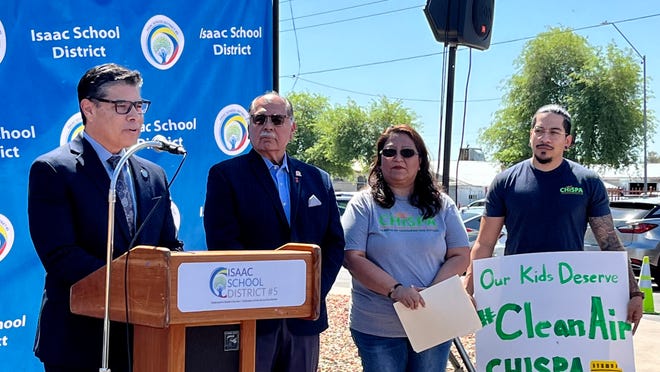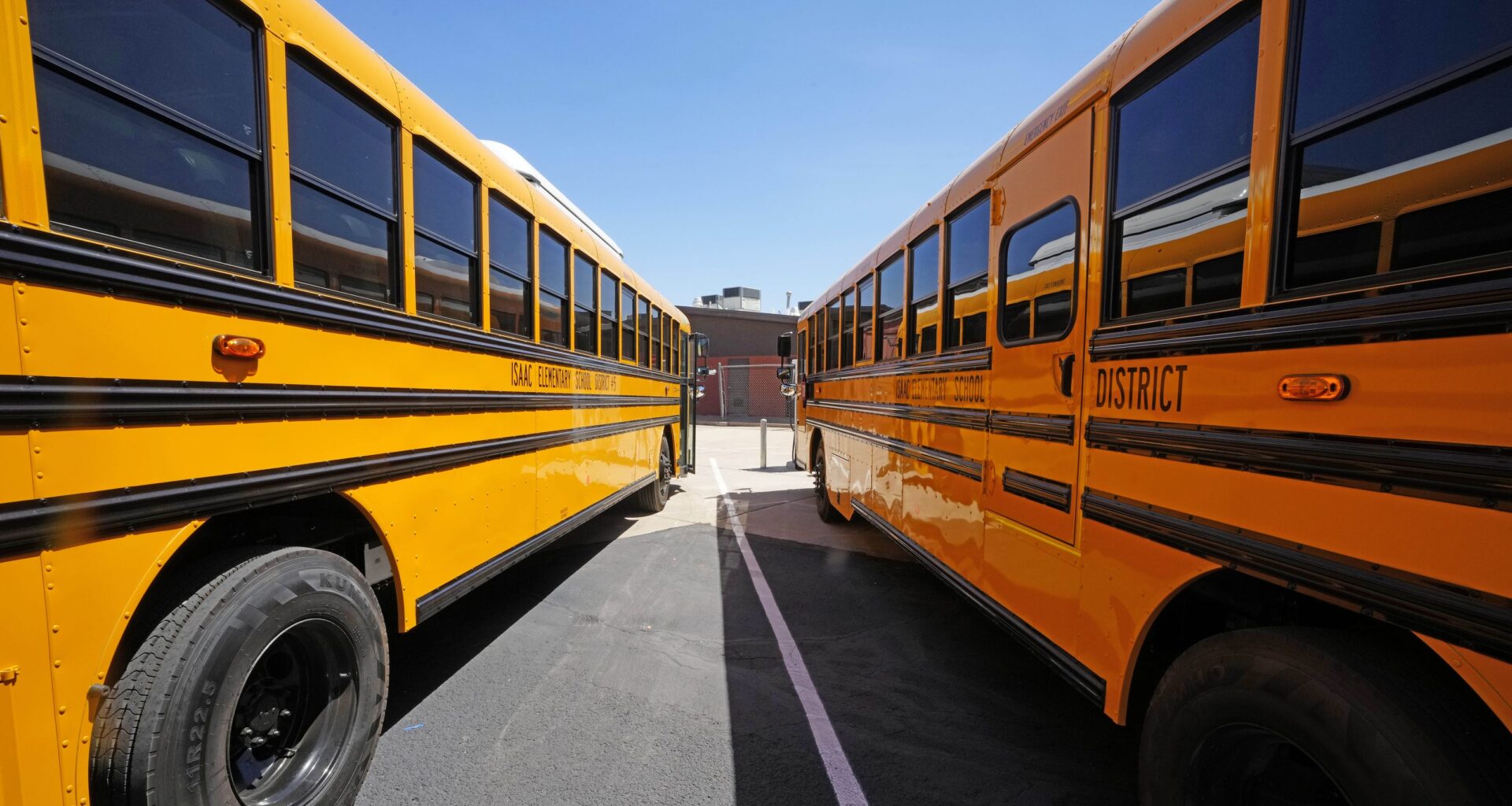
Students in three Maricopa County school districts may soon breathe easier when riding the school bus.
The U.S. Environmental Protection Agency this week announced a nearly $8 million investment toward the purchase of 27 new electric school buses for three Arizona school districts as a part of a national effort to improve air quality, fight climate change, and reduce transportation costs.
Laveen Elementary School District, Gila Crossing Community School on the Gila River Indian Community, and Tempe Elementary School District were among the 70 applicants tentatively selected for the grants, supporting the purchase of over 2,400 zero-emission vehicles nationwide, according to the announcement.
The new buses are funded by the EPA’s Clean Heavy-Duty Vehicles grant program, which was established by the Inflation Reduction Act of 2022. Funds from the program are used to replace heavy-duty vehicles powered by internal combustion engines with new zero-emission models along with chargers.
More than $400 million of the program’s funding is going to communities designated as non-attainment areas for National Ambient Air Quality Standards, which includes Maricopa County.
“Pollution from heavy-duty vehicles contributes to dangerous air quality across the country, including here in Arizona,” said EPA Pacific Southwest Regional Administrator Martha Guzman in the news release. “By replacing dirty heavy-duty vehicles with clean, zero-emission models, this funding will reduce air pollution, improve health outcomes in nearby communities, and advance the campaign to tackle climate change.”
The three school districts will join other districts in the state that have transitioned towards an electrified fleet with help from federal funds. The EPA will work with the districts to finalize the funding by early 2025.
“The idea for the electric school buses is to help reduce the emissions and reduce the respiratory illnesses in the kids,” said Superintendent Jim Mosley of the Gila Crossing Community School. “Anything that we can do to make our students healthier is always a good step to take, and I think this is a good direction to begin.”
Electric buses:These high school runners train in ‘nasty air,’ so they’re working to clean it up
Air quality in Maricopa County is low due to high ozone levels
Metro Phoenix was ranked fifth worst for ozone pollution, according to the American Lung Association’s 2024 State of the Air Report.
Ground-level ozone is the main ingredient of smog. High amounts of it can cause breathing difficulty and aggravate respiratory diseases, like asthma. A major contributor to the Valley’s high ozone levels are tailpipe emissions.
Children are at greatest risk of ozone exposure because they are more likely to be active outdoors when ozone levels are high and their respiratory systems are still developing. They are also more likely than adults to suffer from asthma.
“We note that the transportation sector is one of the largest sources of greenhouse gases and air pollution in the U.S., and that older heavy-duty vehicles in particular emit harmful pollutants like nitrogen oxide and fine particulate matter,” said EPA officials in a statement. “Children, older adults, those with preexisting cardiopulmonary disease, and those of lower socioeconomic status are particularly vulnerable.”
Reducing pollution:How a Phoenix district’s electric school buses could protect kids and help them learn
Electric buses as environmental justice
The Clean Heavy-Duty Vehicles grant program is part of the Biden Administration’s Justice 40 Initiative, which mandates that at least 40% of certain federal investments benefit disadvantaged communities. This includes tribal communities, low-income communities and communities of color that have been disproportionally impacted by air pollution burdens.
Last year, the Arizona Coalition for Change, a grassroots organization serving communities of color, launched the Clean Energy Clear Lungs campaign. The mission of the campaign is to educate the public, promote clean energy solutions, and advocate for state-level policies that reduce air pollution.

“You have heavy-duty trucks that are driving up and down the highway every single day. The emissions and particulates that are coming directly from the highway are directly impacting children,” said Reginald Bolding, a former state lawmaker who founded the group. “When you look at some of the most diverse and lowest-income communities, you see a number of transportation options that are emitting directly into the community.”
Bolding, who holds a doctorate in education, applauded the school districts for securing the funding for the buses, and pointed to other solutions like increasing tree shade cover and the adoption of state-level clean energy policies to continue improving air quality.
“Whether we’re talking about reservations, low income, or urban areas, they are all facing the same issue: air pollutants that are affecting the lung health of the community,” said Bolding.
John Leos covers environmental issues for The Arizona Republic and azcentral. Send tips or questions to john.leos@arizonarepublic.com.
Environmental coverage on azcentral.com and in The Arizona Republic is supported by a grant from the Nina Mason Pulliam Charitable Trust.
Sign up for AZ Climate, our weekly environment newsletter, and follow The Republic environmental reporting team at environment.azcentral.com and @azcenvironment on Facebook and Instagram.
